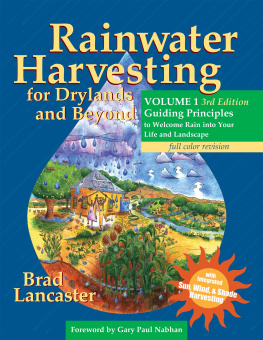Sustainable Living: Rainwater Harvesting For Beginners
A Complete Guide How To Collect, Use And Store Rainwater For Self-Sufficient Backyard Homesteading.
S. J. Hammer
Copyright S.J. Hammer 2021 - All rights reserved.
It is not legal to reproduce, duplicate, or transmit any part of this document in either electronic means or printed format. Recording of this publication is strictly prohibited and any storage of this document is not allowed unless with written permission from the publisher except for the use of brief quotations in a book review.
Under no circumstances will any blame or legal responsibility be held against the publisher, or author, for any damages, reparation, or monetary loss due to the information contained within this book. Either directly or indirectly. You are responsible for your own choices, actions, and results.
Legal Notice:
This book is copyright protected. This book is only for personal use. You cannot amend, distribute, sell, use, quote or paraphrase any part, or the content within this book, without the consent of the author or publisher.
Disclaimer Notice:
Please note the information contained within this document is for educational and entertainment purposes only. All effort has been executed to present accurate, up to date, and reliable, complete information. No warranties of any kind are declared or implied. Readers acknowledge that the author is not engaging in the rendering of legal, financial, medical or professional advice. The content within this book has been derived from various sources. Please consult a licensed professional before attempting any techniques outlined in this book.
By reading this document, the reader agrees that under no circumstances is the author responsible for any losses, direct or indirect, which are incurred as a result of the use of the information contained within this document, including, but not limited to, errors, omissions, or inaccuracies.
Contents
A drop harvested is a crop harvested.
- Unknown
Introduction
Why Harvest Rainwater?
In case you are wondering why you should invest in a self-sustaining water source for your home, there are numerous compelling reasons. For example, nobody can survive without water, and you never know when the public supply will fail. More importantly, arent you burdened or somewhat overstretched by endless water bills?
The undeniable piercing truth is that you may find yourself in a messy water scarcity or stressful water bills quagmire. What you need is to collect and store rainwater or even relocate to obtain enough water to sustain your life and the lives of your family.
Ironically, the public water supply contains numerous additives you may wish to avoid. Chlorine and other chemicals are used to kill germs and viruses to make water drinkable. Yet those same chemicals are toxic in large quantities; who knows what effect they have on our health over time, even in trace amounts? Certain states add additional chemicals to the water supply, such as fluoride, whether residents want them or not. The manufacture of such chemicals is not always regulated, particularly if they are imported, and in most selfish cases, not many seem to care about the possible effects.
Indeed, many public water supplies have been found to contain trace amounts of lead and arsenic, as well as other contaminants. Even stormwater runoff will be contaminated by a variety of chemicals used in agricultural and industrial pursuits. This water enters rivers and lakes, from which our primary source of water is frequently drained.
Why Does It Matter?
It does matter! Not just for you, and not just for this generation, but for our future. Softer water exists for your family only waiting to be fetched in due time. Collecting pure rainwater for use will not only help you live sustainably off the grid and sort out your water needs, but will also help to conserve the public water supply during times when Mother Nature is scarce and the public water supply is dwindling.
In essence, if rainwater is not collected and stored in tanks, it is simply wasted. You are better off using it than letting it run down the drain and out to the sea again! When there is a drought, there is never enough water to go around. You will be restricted from using it for gardening or car washing. With your own supply, your garden will last significantly longer; hopefully, until the drought ends.
Nobody can truly be self-sufficient unless there is a reliable water supply, but there are plenty of ways around this. While some people can dig their own wells, others must rely on the rain to provide sufficient water. Many rural residents have survived for years on harvested rainwater alone. Not all rural residents live near a river or have the ability to dig a well; rather, they have tanks to collect runoff from their homes and sheds.
Because this is their only source of water, they have learned to conserve it to last until the next rain shower replenishes their tanks. We will discuss ways to conserve water in detail in a later chapter, but first, we must learn how to harvest this priceless resource!
Having a secondary source of water also serves as a fire protection measure. Occasionally, the public water system will fail due to an overload during a fire. If you have a tank or two of water at your residence, you can use it to extinguish any sparks that blow toward your residence.
Above all, collecting rainwater is completely free and is the only spare key to unlocking the doors to free water, self-reliance, and eco-friendly habits. Even if your water rates are not excessive, using your own water will significantly reduce those costs on tap or bottled water.
Naturally, you will have to pay for the tank's initial installation, as well as any supporting structure beneath it, downspouts, and guttering. You will require a filter, a pump, and pipes to distribute the water throughout your home and/or garden.
Once all of that is in place, there will be few potential ongoing costs. The only ongoing cost would be if you choose to install filters that must be replaced regularly. However, this is an optional step, as not all states have laws or regulations governing the use of water for private purposes.
This book provides a practical roadmap through a great deal of effort into providing the reader with practical, succinct, and actionable information for rainwater harvesting and constructing a high-quality rainwater harvesting system that will last for years for sustainable living.
Once in a while, you may come across related sections and overlapping material in some circumstances, which is done on purpose to stress the importance and relevance of the system as a whole.
Each chapter builds on the one before it and offers a summary that highlights the most important points addressed for quick reference. This book is for the do-it-yourself homeowner or anyone who wishes to have a well-informed dialogue with the installing contractor. You may also get more information by clicking on many of the component photographs. Sophisticated formulas and calculations are provided in a laypersons easy-to-follow and understandable manner.
Water Facts
Even though water abundantly covers 71% of our planet, less than 1% is suitable for human consumption. The shortage of clean water is still one of the most overwhelming problems that the world continues to face in the 21st century.


















